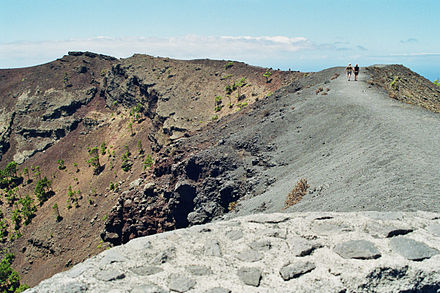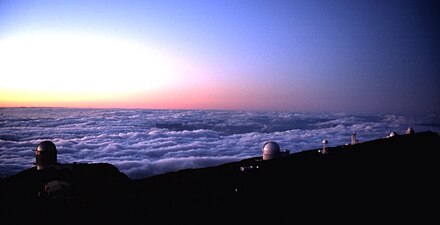La Palma - island in the Canary Island archipelago

 La Palma is an island of the Canary Islands, which are an integral part of Spain. It is near Morocco, Cape Verde and the archipelagos of the Azores and Madeira, both Portuguese. The nickname of the island is "La Isla Bonita" (the beautiful island).
La Palma is an island of the Canary Islands, which are an integral part of Spain. It is near Morocco, Cape Verde and the archipelagos of the Azores and Madeira, both Portuguese. The nickname of the island is "La Isla Bonita" (the beautiful island).

Understand
The island has a small population of just under a hundred thousand. It has one major port (Santa Cruz de la Palma), a second small port (Tazacorte) and an international airport (SPC). The populous municipality is Los Llanos de Aridane.
Ethnically the population is mostly Hispanic (actually a mix of Spanish, Berber and Portuguese), with a small number of European immigrants and very small number of African and Eastern European immigrants.
The island exports bananas, rum, gofio and some tobacco, and hosts a major international astronomical observatory (dead link: August 2018).
Get in
By ship
If you want to travel between the islands a good option might be to take a ship if you are in any particular hurry, specially between close by islands. Most ferries are now quite modern and cheap. The most important companies are Fred Olsen, Transmediterránea and Armas. The ferries operate in the Santa Cruz de la Palma ferry port 📍.
There is a regular ferry connection to Tenerife and freight-only ferries to the other islands, to Cadiz in mainland Spain and the African coast.
By plane
- Santa Cruz de La Palma Airport (IATA: SPC), 28.6235°, -17.753°. Not to be confused with other similarly named airports around the world. If you are afraid of the sea or get sick just by staring at a ship a plane is what you need, and that usually means a turboprop ATR-72 by one of the local airlines like Binter or Islas Airways. They are perfectly safe and adequately fast as you are likely to spend more time at the airport than in the plane itself. There are local direct flights to Tenerife, Gran Canaria and El Hierro. There are flights with Iberia and Binter to/from several airports in mainland Spain including Madrid and Barcelona, Paris, Madeira and Milan. There are also charter flights from Belgium, Germany, The Netherlands and mainland Spain.
Get around
A hire car is the best option for discovering the remote wilderness regions. Roads are well-maintained and marked for traffic control. Only sharp turns and verticals on side roads may challenge some drivers.
By bus
Buses provide an excellent and reliable service. You can print a copy of the timetable here http://transporteslapalma.com/transportes/index.htm (dead link: August 2018). A bus ticket never costs more than €2 if you don't need to change bus. Do not expect the drivers to know more than a couple of sentences in English or German, though they will try to be helpful.
By taxi
Taxis can be expensive, and inside a city they are not worth the money unless you are in a real hurry or can't balance yourself after a shopping day. It is unlikely that you would be cheated. From the airport to Puerto Naos costs roughly €35 (May 2006).
See
There are a few nice towns, but the main attraction is the countryside. Spectacular volcanic landscapes reaching up above the clouds with dense vegetation in the valleys make for some spectacular hiking.
The highest point on the island, El Roque de los Muchachos (2426m -- about 8000 feet), is easily accessible by car most of the year and the views from there are spectacular and provide a good introduction to the geography of the island (note that access is restricted at night as this is the site of a major international astronomical observatory -- always read the signposts -- also note that roads and trails can be closed for a few days in the winter due to snow). There is a very extensive network of marked walking trails over the whole island which are well signposted and walking maps are available from the tourist office in Santa Cruz.
Along the northeast coast, you'll find masses of intricately terraced crops (especially bananas) interlaced with small towns and villages.
In the middle of the island there is Caldera de Taburiente, a huge erosion crater which is one of the biggest in the world. Guided hikes to the caldera are available. During winter months hiking on the river bed in the caldera can be really dangerous because rain can cause flash floods.
The capital of the island, Santa Cruz, has lots of well preserved old buildings and cobblestone streets. Along Avenida Maritima you can see old Canarian balconies made from the Canary pine.


- Observatorio del Roque de los Muchachos, 28.75972°, -17.88667°.
- Lighthouse of Fuencaliente, 28.455556°, -17.843333°.
- National Park de la Caldera de Taburiente, 28.753928°, -17.884719°.
- Parque Arqueologico de Belmaco, 28.57806°, -17.77651°.
- Roque de Los Muchachos, 28.754167°, -17.884722°.
- Charco Azul, 28.807952°, -17.761622°.
- Eco Finca Platano Logico, 28.58367°, -17.90808°. A mostly organic banana orchard with visitor center.
- La Palma Maritime Museum, Plaza de la Alameda (Santa Cruz de la Palma), 28.6881957°, -17.7610887°, +34 922 411 787, reservas@museonavallapalma.es.
- Parque Cultural La Zarza, San Antonio, Garafia, +34 922 69 50 05.
- Archaeological Museum Benahoritas, Los Llanos de Aridane, 28.65682°, -17.91021°.
Do
.jpg/440px-Inside_the_Caldera_de_Taburiente_4_(5489423342).jpg)
- Los Tilos laurel forest, 28.79039°, -17.80167°. If possible get four wheel taxi up to start of walk. Then walk around the canal (what in Madeira would be called a levada) following the contours of a steep tree-lined barranco walking through 13 tunnels (stooping to avoid hitting your head). Tunnel number 12 is wet inside - one guide book described it as like a power-shower. Then down through the laurisilva forest (a tiring but stunning descent of about ). Also don't miss the lookout - a volcanic dyke about two feet wide with sheer drops on both sides, but protected by handrails with totally stunning 360 degree views - makes Symond's Yat look a bit pathetic. Details of the walk are in Walk! La Palma (dead link: December 2020) and also in the Sunflower book guide though take the times given for the walk with a pinch of salt - this took us about 6 hours. But well worth the effort. See picture at right.
- Ruta del los Volcanos, 28.5708°, -17.8382°. Part of the GR 131 long distance path - along the length of the Cumbre Vieja, a route with fabulous views all round, and with volcanic craters for most of the length. Again, quite a demanding walk on a hot day, and dust kicked up by walking companions gets everywhere, but a stunningly memorable walk.
- GR130 walking route. For the fit and enthusiastic. It goes right around La Palma mainly on the historic donkey paths. It takes a minimum of seven days which would require walking around eight hours of tough walking daily. If possible take at least a couple of days extra. Can be done on a budget by using pensions where possible. The constantly changing scenery is stunning, you will meet some interesting locals on the way and it is an experience to remember.
- The island also organises the Transvolcania which is a run up the Volcano route - and beyond. Check out http://www.senderosdelapalma.com/ for info on all walking routes.
Eat
See Canary Islands#Eat for an overview of local foods.
- Goat - cabrito (young goat, usually fried) Cabra (older goat, usually stewed).
- bienmesabe - means 'tastes me good' and it does - ground almonds in honey, it is very sweet.
Drink
Espresso with sweetened condensed milk, and sometimes a shot of alcoholic liquor is a local speciality -- Barraquito. The island has a large amount of vineyards. Shakespeare mentioned the Malvasia (sweet Malmsey) coming from the Canary Islands. Excellent wine made on La Palma can be bought at specialist outlets and at most supermarkets.
Locally made rum is also available.
Sleep
There are tourist hotels and apartments in both Santa Cruz and Los Llanos, the two main 'cities' on the islands. Also in Los Cancajos and Puerto Naos (the two main beach locations), plus Barlovento in the north and Los Canarios in the south.
There is a wide variety of country cottage and gites-type accommodation in most parts of the island. These are referred to as casitas and are bookable via the government run website www.islabonita.com, various agencies or privately.
There are three pensions in Santa Cruz called, La Cubana, La Fuente and Los Canarios which have a range of accommodation from apartment to basic room with prices to reflect this. There is a very nice hostel in Los Llanos de Aridane, called Rosaburiente. Also pensions in Los Sauces, San Andres, Roque Faro, Puntagorda and Los Canarios.
Camping is allowed on La Palma at the following designated camp sites, although a permit is required (except at La Rosa):- Centro de Naturaleza La Rosa at Puntagorda which is two minutes from the main road and on the GR130 walking route. You can walk to the shops/restaurants in Puntagorda, Refugio El Pilar above El Paso which is accessible by road (no bus service) and is right on the GR131 route and at the start of the volcano route. Permit from the Casa Forestal at the side of the Visitors Centre above El Paso. La Laguna de Barlovento permit available on site and there is also a restaurant/bar here and Caldera de Taburiente only accessible on foot - 4 hour walk or Land Rover taxi and two hour walk - and you will need to take all your own supplies. A permit is required - ask at Visitors Centre. Charges are usually small and facilities usually good/rustic. All a great experience though!
Stay safe
112 is the common emergency number.
Go next
La Palma
cabildodelapalma.esProvincia de Santa Cruz de Tenerife
2nd-order administrative division
Canary Islands
Primary administrative division